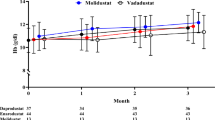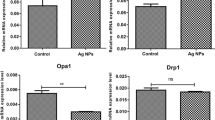Abstract
Long-term exposure of rats to cadmium (Cd) resulted in a marked suppression of erythropoietin (Epo) mRNA expression in the kidneys and the development of severe anemia. A recent report revealed that Cd inhibited hypoxia-inducible factor 1 (HIF-1) binding activity and Epo mRNA expression and protein production. However, Epo gene expression is also regulated by transcription factor GATA-2, which binds to the GATA binding site of the Epo promoter. To elucidate the mechanism of suppression of Epo by Cd, the effect of Cd on GATA-2 function was studied. Epo promoter/enhancer luciferase constructs, one with the wild-type promoter and another with a promoter with a mutant GATA site, were transfected into Hep3B cells. No significant difference in Epo promoter activity in these two types of cells was observed in the presence of Cd. The binding activity of GATA-2 was not affected by Cd. This study showed that Cd inhibited HIF-1 binding activity and Epo promoter activity, and then suppressed Epo protein production. Inhibition of Epo gene expression by Cd depends on suppression of HIF-1 binding activity, not on alteration of GATA function.







Similar content being viewed by others
References
Blanchard KL, Acquaviva AM, Galson DL, Bunn HF (1992) Hypoxic induction of the human erythropoietin gene: cooperation between the promoter and enhancer, each of which contains steroid receptor response elements. Mol Cell Biol 12:5373–5385
Fandrey J, Frede S, Jelkmann W (1994) Role of hydrogen peroxide in hypoxic induced erythropoietin production. Biochem J 303:507–510
Faquin WC, Schneider IJ, Goldberg MA (1992) Effect of inflammatory cytokines on hypoxia-induced erythropoietin production. Blood 79:1987–1994
Fariss MW (1991) Cadmium toxicity: unique cytoprotective properties of alpha tocopheryl succinate in hepatocytes. Toxicology 69:63–77
Horiguchi H, Teranishi H, Niiya K, Aoshima K, Katoh T, Sakuragawa, N (1994) Hypoproduction of erythropoietin contributes to anemia in chronic cadmium intoxication: clinical study on Itai-Itai disease in Japan. Arch Toxicol 68:632–636
Horiguchi H, Sato M, Konno N, Fukushima M (1996) Long term cadmium exposure induces anemia in rats through hypoproduction of erythropoietin in the kidneys. Arch Toxicol 71:11–19
Horiguchi H, Kayama F, Oguma E, Willmore WG, Hradecky P, Bunn HF (2000) Cadmium and platinum suppression of erythropoietin production in cell culture: clinical implications. Blood 96:3743–3747
Huang LE, Arany Z, Livingston DM, Bunn HF (1996) Activation of hypoxia-inducible transcription factor depends primarily upon redox-sensitive stabilization of it's α–subunit. J Biol Chem 271:32253–32259
Huang LE, Gu J, Schau M, Bunn HF (1998) Regulation of hypoxia-inducible factor 1α is mediated by an O2-depengdent degradation domain via the ubiquitin-proteasome pathway. Proc Natl Acad Sci USA 95:7987–7992
Imagawa S, Yamamoto M, Ueda M, Miura Y (1996) Erythropoietin gene expression by hydrogen peroxide. Int J Hematol 64:184–195
Imagawa S, Yamamoto M, Miura Y (1997) Negative regulation of the erythropoietin gene expression by the GATA transcription factors. Blood 89:1430–1439
Imagawa S, Tarumoto T, Suzuki N, Mukai HY, Hasegawa Y, Higuchi M, Neichi T, Ozawa K, Yamamoto M, Nagasawa T (2002) l-Arginine rescues decreased erythropoietin gene expression by stimulating GATA-2 with l-NMMA. Kidney Int 61:396–404
Ivan M, Kondo K, Yang H, Kim W, Valiando J, Ohh M, Salic A, Asara JM, Lane WS, Kaelin WG Jr (2001) HIF-1α targeted for VHL-mediated destruction by proline hydroxylation: implications for O2 sensing. Science 292:464–468
Jaakkola P, Mole DR, Tian YM, Wilson MI, Gielbert J, Gaskell SJ, Kriegsheim A, Hebestreit HF, Mukherji M, Schofield CJ, Maxwell PH, Pugh CW, Ratcliffe PJ (2001) Targeting of HIF-1α to the von Hippel-Lindau ubiquitylation complex by O2-regulated prolyl hydroxylation. Science 292:468–472
Jelkmann W, Fandrey J, Wiedemann G (1990) Immunoreactive erythropoietin in the anemia of non-renal chronic disease. Biomed Biochim Acta 49:S265–S270
Jelkmann W, Pagel H, Wolff M, Fandrey J (1992) Monokines inhibiting erythropoietin production in human hepatoma cultures and in isolated perfused rat kidneys. Life Sci 50:301–308
Kasuya M, Teranishi H, Aoshima K, Katoh T, Horiguchi H, Morikawa Y, Nishijo M, Iwata K (1992) Water pollution by cadmium and the onset of Itai-itai disease. Water Sci Technol 25:145–156
La Ferla K, Reimann C, Jelkmann W, Hellwig-Burgel T (2002) Inhibition of erythropoietin gene expression signaling involves transcription factors GATA-2 and NF-κB. FASEB J 16:1811–1813
Means RT, Krantz SB (1992) Progress in understanding the pathogenesis of the anemia of chronic disease. Blood 80:1639–1647
Semenza GL, Wang GL (1992) A nuclear factor induced by hypoxia via de novo protein synthesis binds to the human erythropoietin gene enhancer at a site required for transcriptional activation. Mol Cell Biol 12:5447–5454
Tabata M, Tarumoto T, Ohmine K, Furukawa Y, Hatake K, Ozawa K, Hasegawa Y, Mukai H, Yamamoto M, Imagawa S (2001) Stimulation of GATA-2 as a mechanism of hydrogen peroxide suppression in hypoxia-induced erythropoietin gene expression. J Cell Physiol 186:260–267
Tarumoto T, Imagawa S, Ohmine K, Nagai T, Higuchi M, Imai N, Suzuki N, Yamamoto M, Ozawa K (2000) N G-monomethyl-l-arginine inhibits erythropoietin gene expression by stimulating GATA-2. Blood 96:1716–1722
Yamamoto M, Ko LJ, Leonard MW, Beug H, Orkin SH, Engel JD (1990) Activity and tissue-specific expression of the transcription factor NF-E1 multi gene family. Genes Dev 4:1650–1662
Acknowledgements
We thank Hiromi Tanaka and Ayako Hoshino for their expert technical assistance. This work was supported by Grants-in-aid for scientific research from the Ministry of Education, Science and Culture of Japan, and the Renal Anemia Foundation, Japan.
Author information
Authors and Affiliations
Corresponding author
Rights and permissions
About this article
Cite this article
Obara, N., Imagawa, S., Nakano, Y. et al. Suppression of erythropoietin gene expression by cadmium depends on inhibition of HIF-1, not stimulation of GATA-2. Arch Toxicol 77, 267–273 (2003). https://doi.org/10.1007/s00204-003-0444-0
Received:
Accepted:
Published:
Issue Date:
DOI: https://doi.org/10.1007/s00204-003-0444-0




